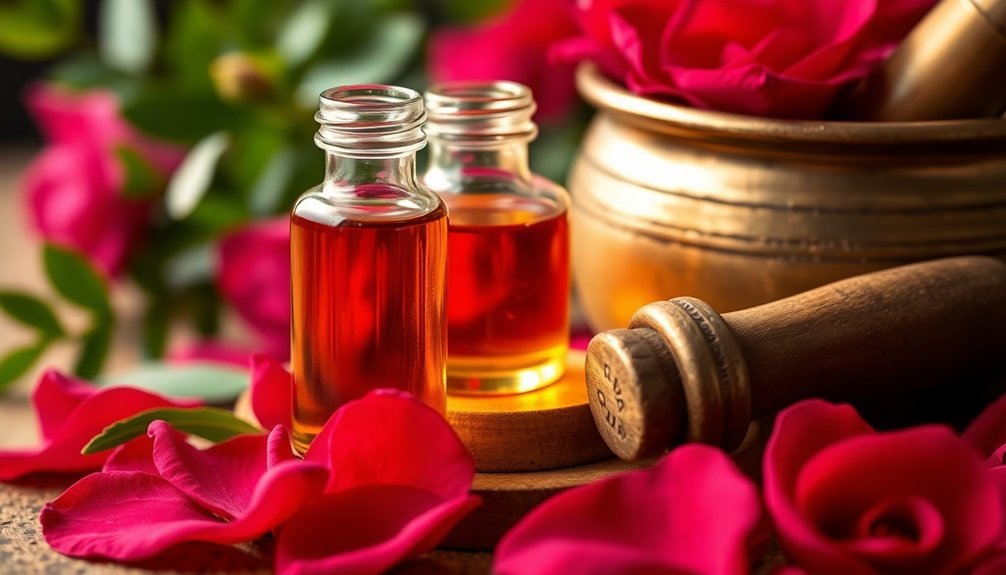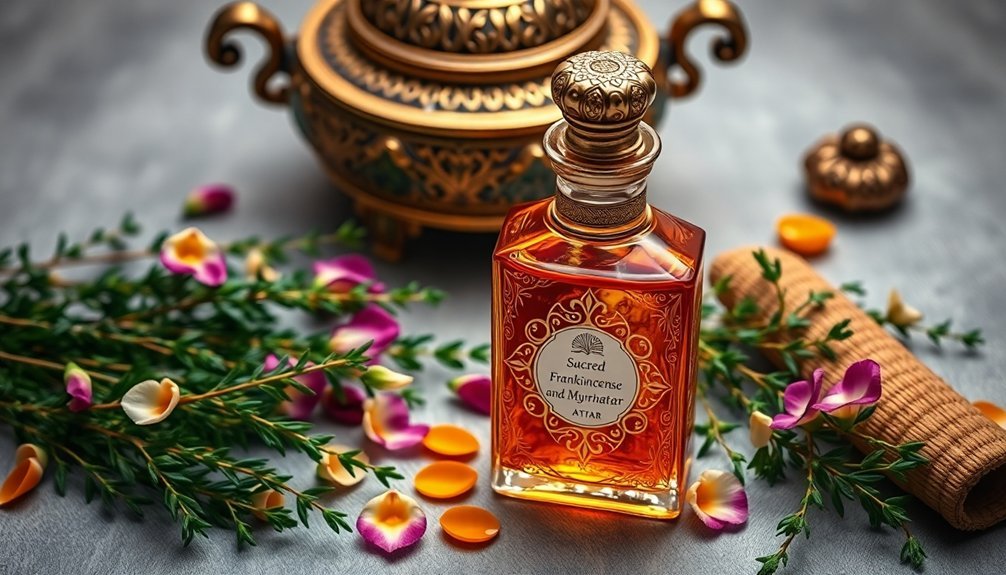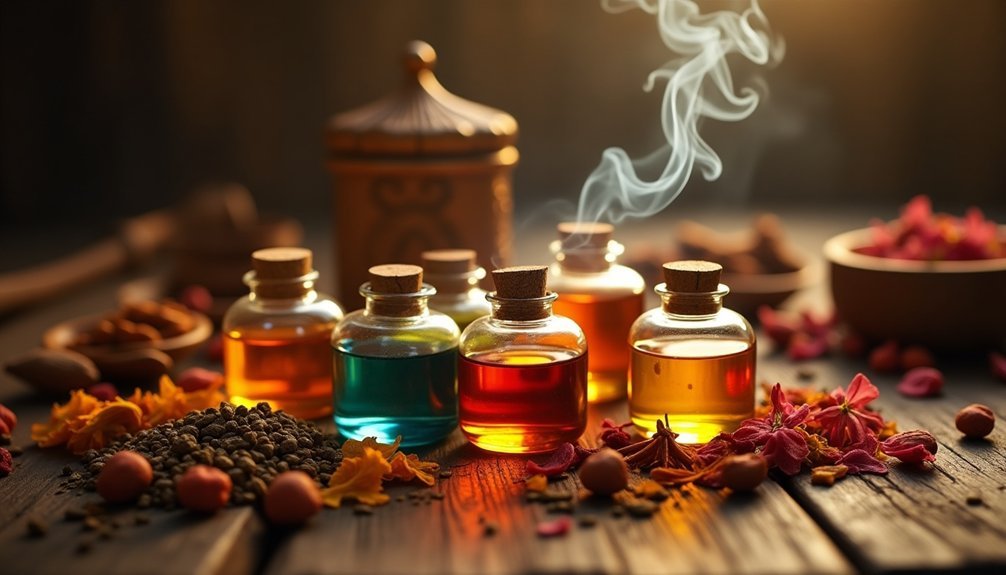The most coveted attar recipes combine precious aromatics like oud, rose, and sandalwood using time-honored techniques. You'll discover seven legendary blends: the classic Rose-Sandalwood fusion, Royal Oud-Amber formula, Traditional Arabian Musk, Sacred Frankincense-Myrrh blend, Ancient Persian Jasmine method, Mystical Agarwood-Saffron mix, and Noble Vetiver-Lotus combination. These recipes use both traditional deg bhapka distillation and modern infusion approaches to create rich, complex fragrances. The ancient secrets of these aromatic treasures await your exploration.
Classic Rose and Sandalwood Attar Recipe

A classic rose and sandalwood attar captures the timeless essence of traditional perfumery.
You'll need a large glass jar, 200ml of pure sandalwood oil, and half a kg of fresh rose petals to create this fragrant blend.
Begin by combining the sandalwood oil and rose petals in your jar, sealing it tightly. Place the mixture in a dark, dry spot for two weeks.
After this initial period, you'll need to mash the petals every other day for an additional week using a hand masher or large spoon.
The concentrated nature of attar means a few drops will provide long-lasting fragrance throughout the day.
Once the infusion process is complete, strain the mixture using a plastic pipette or sieve.
While commercial methods use complex deg bhapka systems, this simplified home technique delivers similar results.
Store your finished attar in a roll-on glass bottle, keeping it in a cool, dry place to preserve its rich aroma.
Royal Oud and Amber Blend Formula
You'll need premium-grade oud oil, amber resin, and select top notes like pink pepper and bergamot to create this luxurious royal blend.
For best results, combine your ingredients at a 15-17% concentration using a glass mixing vessel, carefully layering each note while allowing proper settling time between additions. Adding clove and cardamom to your heart notes will enhance the depth of your blend.
Once blended, transfer your creation to a dark glass bottle and let it age for at least 30 days in a cool, dark place to achieve the signature smooth finish characteristic of royal oud formulations.
Essential Recipe Components
The essential components of a Royal Oud and Amber blend fall into three distinct layers: top notes featuring pink pepper and citrus elements, middle notes centered around angelica and cedarwood, and base notes anchored by musk and agarwood.
You'll need fresh, bright ingredients like lime, bergamot, and galbanum for your top notes, which create an immediate impact. This sophisticated blend carries a luxurious captivating scent that has made it highly sought-after.
For the middle layer, combine angelica's herbaceous sweetness with cedarwood's dry character, enhanced by cardamom and floral notes like rose or jasmine.
Your base notes should include musk for longevity, ambroxan for warmth, and the star ingredient – agarwood (oud) – for its distinctive resinous profile.
For added complexity, you can incorporate luxury elements like ambergris, saffron, or civet, though these aren't essential to achieve the classic Royal Oud character.
Premium Blending Instructions
Building on our understanding of key components, precise blending techniques determine the success of your Royal Oud and Amber creation.
You'll want to start with the base concentration of 15-17% for an Eau de Parfum strength, carefully measuring each note layer by layer.
Begin with your top notes – bergamot, lime, galbanum, and pink pepper – which should comprise about 20% of your blend.
Next, add your middle notes of angelica, cedarwood, and cardamom, making up roughly 30% of the mixture.
Finally, incorporate your base notes of musk, ambroxan, and agarwood, which form the remaining 50%.
For best results, use Grade A quality ingredients and guarantee proper IFRA compliance if you're creating fine fragrances or body sprays.
Let your blend mature for at least 24 hours before final assessment.
Storage and Aging Process
Proper storage conditions play an essential role in preserving your Royal Oud and Amber blend's complex aromatic profile.
Keep your blend in a dark glass bottle at temperatures between 60-80°F, away from direct sunlight and heat sources. Don't store it in bathrooms or kitchens where humidity can affect the oils.
When handling your blend, use clean hands and avoid touching the bottle's nozzle directly to your skin. Instead, use a clean glass applicator or dipstick.
Always seal the bottle tightly after use to minimize air exposure. You'll want to place the bottle in a specialized storage box for additional protection against light and temperature fluctuations.
Monitor your blend regularly for any changes in scent, color, or texture. If you notice any negative changes, it's time to replace it.
Traditional Arabian Musk Attar Recipe
Creating traditional Arabian musk attar involves three essential components: a rich musk source, carefully selected carrier oils, and specialized distillation equipment.
You'll need a copper still (Deg), receiver (Bhapka), and cooling tank (Gachchi) for proper distillation.
Begin by placing your musk source in the Deg with sandalwood or jojoba oil as a carrier. Heat the mixture in the traditional furnace (Bhatti), allowing steam to pass through and collect in the Bhapka.
The condensed vapors will blend with your base oil, capturing the intense fragrance. Filter the mixture through fine silk to guarantee purity.
Let your attar mature for several weeks in an airtight container. During this time, the scent will develop its characteristic sweet, animalistic notes with subtle leather and woody undertones.
Sacred Frankincense and Myrrh Attar Blend

While Arabian musk attar captures the essence of ancient perfumery, the sacred combination of frankincense and myrrh offers a deeper spiritual dimension in attar making. You'll need to blend 10 drops of myrrh with 6 drops of frankincense in a clean glass bottle, then add 8 drops of sandalwood and 4 drops of lavender for balance. Fill the remainder with 30ml of jojoba oil as your carrier.
| Emotional Benefits | Spiritual Connection |
|---|---|
| Inner Peace | Divine Protection |
| Mental Clarity | Sacred Purification |
| Emotional Balance | Spiritual Awareness |
| Stress Relief | Ancient Wisdom |
| Deep Meditation | Soul Connection |
Remember to let your blend rest for 48 hours to mature. Always perform a patch test before use, and keep the mixture away from children and pets. This timeless combination carries both therapeutic and spiritual properties that have been cherished for millennia.
Ancient Persian Jasmine Attar Method
You'll need a traditional copper still (Deg), a Bhapka receiver, and premium-quality jasmine flowers to start crafting Persian jasmine attar.
The setup requires a Bhatti furnace for heating and a Gachchi cooling tank to properly condense the steam during distillation.
Your materials must also include pure Mysore sandalwood oil as the base carrier, along with supplementary ingredients like musk and saffron for creating an authentic Persian blend.
Equipment and Materials Needed
To craft authentic Persian jasmine attar using traditional methods, you'll need both specialized equipment and specific natural materials.
Your essential equipment should include a still for bain-marie distillation (taqṭīr be'l-roṭūbat), glass collection vessels, a mortar (hāvan), and a grinding stone (ṣalāyat). You'll also need cooking pots called tenjār or tūr, and a charcoal heat source for maintaining steady, smoke-free temperatures.
For materials, gather fresh jasmine flowers, binding agents like oak-gall or resin to create the base paste (rokn), and thickeners such as purified vegetal tar (qeṭrān).
You'll want to include complementary ingredients like rose essence, myrtle, or saffron to enhance the fragrance.
Don't forget essential storage supplies – glass bottles for the finished attar or materials to form and dry the perfume into small disks.
Step-by-Step Persian Process
Since ancient times, Persian artisans have perfected the intricate process of crafting jasmine attar through methodical steps passed down through generations.
You'll start by gathering fresh jasmine flowers at dawn when their fragrance peaks, selecting only the finest blooms for processing.
Next, you'll place the flowers in a copper still (deg) with water and heat them to create steam. As the steam carries the essential oils through a bamboo pipe, it condenses in the receiver (bhapka).
You'll notice the liquid separates naturally – the precious attar floating above the water.
Once you've collected the attar, mix it with sandalwood oil and filter out impurities.
The final step requires patience: age your attar in leather or glass bottles for several weeks, stirring occasionally. This maturation develops the complex, lasting fragrance that's prized worldwide.
Mystical Agarwood and Saffron Attar Mix

Whether you're drawn to its spiritual significance or its enchanting aroma, the Mystical Agarwood and Saffron Attar Mix represents one of perfumery's most treasured combinations.
You'll need pure sandalwood oil as your base, agarwood (oud) chips or oil, and about a gram of saffron strands.
While traditionalists use the deg bhapka method with copper vessels, you can create this luxurious blend at home using a simpler approach.
Start by combining 200ml of sandalwood oil with your saffron strands in a glass jar. Store it in a dark place for two weeks, mashing the saffron every other day to release its essence.
After your waiting period, strain the mixture into a glass bottle.
Apply the finished attar to your pulse points, and you'll experience this timeless fragrance's full mystical effect.
Noble Indian Vetiver and Lotus Attar Blend
The Noble Indian Vetiver and Lotus Attar blend combines ancient aromatherapy wisdom with modern perfumery techniques.
You'll need a carrier oil like sandalwood, coconut, or jojoba as your base. Add vetiver essential oil for grounding properties and lotus attar for its sensual floral notes. Enhance the blend with jasmine or rose attar, and consider adding cedarwood or lavender for depth.
For traditional authenticity, incorporate fresh lotus petals and saffron strands.
Mix your ingredients in a glass jar, allowing them to infuse for 48 hours. If you're following the traditional deg bhapka method, use a copper pot and receiver connected by bamboo pipe.
Store your finished attar in dark glass bottles and let it settle for 24 hours before use.
Frequently Asked Questions
How Long Does Homemade Attar Typically Last Before Losing Its Fragrance?
Your homemade attar can last for decades if you store it properly in airtight, dark containers away from sunlight. With proper temperature control and minimal air exposure, it'll maintain its fragrance strength indefinitely.
Can Synthetic Alternatives Be Used Instead of Natural Ingredients?
Yes, you can use synthetic alternatives instead of natural ingredients. They're often more affordable and consistent, but you'll notice they lack the complex depth and cultural authenticity that natural ingredients provide in your fragrance.
What Are the Signs That an Attar Has Gone Bad?
You'll know your attar has gone bad if you notice changes in its scent becoming weaker or rancid, color darkening or fading, texture becoming uneven, or excessive sediment forming at the bottom.
Is It Safe to Apply Homemade Attar Directly to Skin?
No, you shouldn't apply homemade attar directly to skin. You'll need to dilute it with carrier oils at a 20:80 ratio. Always do a patch test first to avoid potential allergic reactions.
Why Do Some Attars Change Color Over Time?
Your attar's color changes primarily due to light exposure, oxidation, and temperature fluctuations. When you don't store it properly, chemical reactions occur between ingredients and environmental factors, causing visible shifts in appearance.
In Summary
Now you've learned these seven timeless recipes for creating luxurious traditional attars and oud blends. Whether you've chosen the romantic Rose and Sandalwood or the majestic Royal Oud and Amber, you'll be carrying on centuries-old perfumery traditions. Don't be afraid to experiment with these formulas – they're your gateway to mastering the ancient art of natural perfumery. Start small, be patient, and let your nose guide you.
References
- https://www.kashmirica.com/blog/how-to-make-attar-at-home/
- https://www.pujaperfumery.com/how-to-make-attar-at-home/
- https://archive.org/stream/conciseetymologi00skea_1/conciseetymologi00skea_1_djvu.txt
- https://www.ouddict.com/threads/personal-attar-creation.5437/
- https://anthonymarmin.com/the-perfume-blog/attar-perfume
- https://www.ouddict.com/threads/rose-sandalwood-attar.7011/
- https://www.youtube.com/watch?v=PVtH7TzXMTY
- https://basenotes.com/community/threads/advice-on-the-sandalwood-based-rose-formula.474772/
- https://creative-formulas.com/product/royal-oud-type-formula/
- https://amuzefragrance.com/products/oud-aseel





Leave a Reply